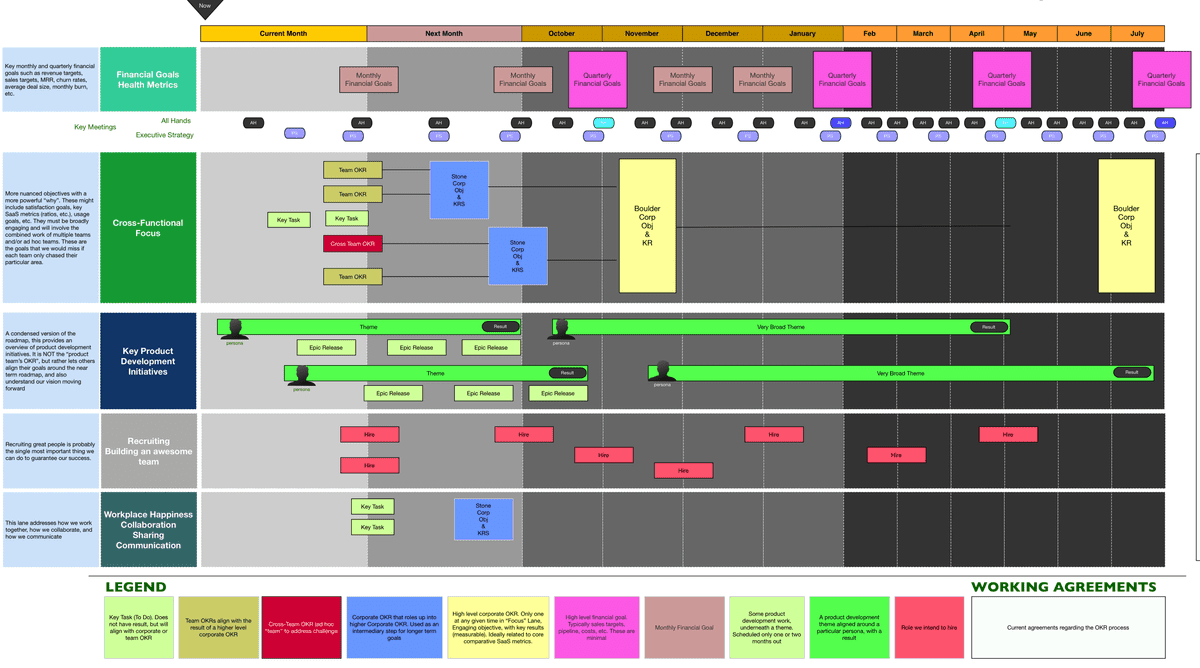Note: A 1.3MB version of this imagine can be found here. I use the term OKR below. To learn more about OKRs see here. I use a diagram (not a photo) here for confidentiality reasons.
Do you use OKRs? Can you visualize the work of a 100–300 person company on a single “board” ? I think so. With this format, I’m trying to address four key problems:
- Visualizing how team-level goals and company goals interact
- Big batch planning
- Confusion over cross-team and team based goals
- Confusion over “we’d do that anyway” goals and powerful, mission-based goals The most important characteristic of the board’s format is that it is continuous. The leftmost column is always Month 0. As we move into the future, there’s less room for detail. Month 0, the current month, is significantly bigger than month 6. Vertical height constrains the number of cross-functional objectives (Boulders) we can pursue at once. In this example it is a single item. The board is always kept up to date, and represents our current reality. It is big, but that is what walls are for.
I break down the elements below, but here is the board in its loveliness:
 The Board. A 1.3MB version of this imagine can be found here
The Board. A 1.3MB version of this imagine can be found here
.There are five swim-lanes on the board. Why five?
I’m a big fan of a singular focus. But in talking to teams, I noticed that financial goals rarely have salience. These goals are seen as a leading indicator of doing great things, but are not the great things themselves. So when picking OKRs, you always have this struggle over whether to include them. It’s the same deal with health metrics. While important — you don’t want to drive your company into the ground — they are something we monitor constantly. So I lump those into a single swim-lane.
- Financial Goals & Health Metrics. Key monthly and quarterly financial goals such as revenue targets, sales targets, MRR, churn rates, average deal size, monthly burn, etc.
 Financial goals and health metrics (and cadenced meetings)
Financial goals and health metrics (and cadenced meetings)
Then you have recruiting and workplace happiness. These are always in play. If we let them falter, we will pay for it at some point in the future. In a rapidly scaling environment, you’ll always encounter issues like “cross-team collaboration, tools, noise, meetings”. Should these be OKRs? I don’t think so. But continuous improvement is important, and should be recognized.
- Recruiting. Recruiting great people is probably the single most important thing you can do to improve your chances
- Workplace Happiness. This lane addresses how we work together, how we collaborate, and how we communicate.

Recruiting and workplace happinessThen we have “the roadmap”. Again, this is going to exist somewhere, so it might as well be visible in front of the whole company. As always, it is suitably decomposed. Items towards the right are higher level. Items to the left are a tad more prescriptive.
Key Product Development Initiatives. A condensed version of the roadmap, this provides an overview of product development initiatives. It is NOT the “product team’s OKR”, but rather lets others align their goals around the near term roadmap, and also understand the vision moving forward
 Key product development initiativesWhich leave us the cross-functional focus lane. This is where the rubber meets the road. At any give time you’ll have one (or two)
Key product development initiativesWhich leave us the cross-functional focus lane. This is where the rubber meets the road. At any give time you’ll have one (or two)very compelling and engaging high level company OKR, broken down into smaller chunks for individual teams and cross-functional groups.
Cross-Functional Focus. More nuanced objectives with a more powerful “why”. These might include satisfaction goals, key SaaS metrics (ratios), usage goals, etc. They must be broadly engaging and involve the combined work of multiple teams and/or ad hoc teams. These are the goals that you’d miss if each team only chased their particular area.

In terms of regular meetings, we find:
 * A bi-weekly all-hands meeting, with extended meetings quarterly, extra extended meetings every six months, and an annual meeting. This is used to adjust/adapt the board accordingly, and to reflect on results
* A bi-weekly all-hands meeting, with extended meetings quarterly, extra extended meetings every six months, and an annual meeting. This is used to adjust/adapt the board accordingly, and to reflect on results
- A product strategy working group meeting to align key stakeholders. Bringing the company together to problem-solve is an exercise in futility if some of the key stakeholders (executives) lack a shared understanding
The items on the board are color coded (see legend):
- Key Task (To Do). Does not have result, but will align with corporate or team OKR
- Team OKR, aligned with the result of a higher level corporate OKR
Cross-Team OKR (ad hoc “team” to address challenge) - Corporate OKR that role up into High Level Corporate OKR. Used as an intermediary step for longer term goals
- High Level Corporate OKR. Only one at any given time in “Focus” Lane, Engaging objective, with key results (measurable). Ideally related to core comparative SaaS metrics.
- High Level Financial Goal. Typically sales targets, pipeline, costs, etc.
Epics. Some product development work, underneath a theme. Scheduled only one or two months out - Theme. A product development theme aligned around a particular persona, with a result
- Role we intend to hire Let me know what you think!